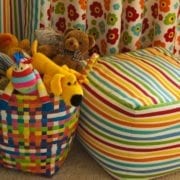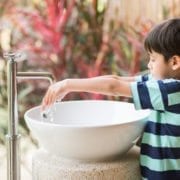How to Get Your Tot to Be Tidy
Nothing is more frustrating than coming home from a long day and finding your child’s room a complete mess. With toys and clothes scattered everywhere around the room, it’s hard not to lose your mind right then and there. Thankfully, there’s another option – just teach your child to clean the clutter themselves!
5 Ways to get your tot to be tidy
Keep things at a child’s level. Looking at things from your child’s eye level will give you a better perspective on how to help them get organized. For example, closet hanging rods may be out of reach for your little ones, so lowering the rod and accompanying it with child-sized hangers will make it easier for them to put away his own clothing and keep the closet organized. It’s also important to make sure that things like cubbies and dresser drawers are at their level so they can put things away on their own.
Teach your child organizational skills. Instead of getting mad at your children for leaving their room a total mess, teach them skills and maintenance methods that they can use to organize their room. This will allow them to adopt efficient ways to keep their room clean on a daily basis. One way to do this is to ask yourself what’s working and what’s not working for them. Also, be sure to know what is important to your child so you can explain to them why staying organized is important in a way that is meaningful to them. For example, if they are frustrated because they can’t find a favorite toy, be sure to use that as an opportunity to explain how being organized and putting things back where they belong can help them find their things more easily!
Create a system. Sorting, storing, and simplifying will make it so much easier for your child to keep their room organized. Start by keeping clothing sorted according to style and season. For example, you can keep all pants in one drawer and all shirts in a separate drawer. Things like jackets and hoodies can be stored in the back of the closet, under the bed, or on higher shelves during the summer months when your child won’t be using them.
Label everything. Printing out photos of the inside contents of a drawer and slapping them on the outside of each corresponding drawer, will help remind your child of where each item belongs. You can also put them on the inside of toy boxes or storage containers so if they decide to dump the stuff out, they will still know where everything goes back by looking at the photo inside.
Make a maintenance routine. Creating a regular routine can help your child stay organized and not feel overwhelmed. It’s usually a good idea to break things up according to time of day. So you can assign tasks like making the bed and putting dirty clothes in the hamper as the “morning pickup” and tasks like putting toys away and getting their outfits ready for the next day as the “evening pickup.”
Our Take
At Carpe Diem, our aim is to create an invigorating and orderly environment for your child. We believe that this kind of balanced environment leads to inspiring thoughts and good habits that will follow them into the future. That is why we keep all of the materials in our classrooms at “child level” – not the teacher’s /adult level. We know that when a child gets things and puts them away by themselves they are experiencing independence, which is a fundamental part of child development.






